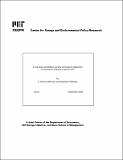A Top-down and Bottom-up look at Emissions Abatement in Germany in response to the EU ETS
Author(s)
Feilhauer, Stephan M. (Stephan Marvin); Ellerman, A. Denny
Download2008-017.pdf (2.544Mb)
Metadata
Show full item recordAbstract
This paper uses top-down trend analysis and a bottom-up power sector model to define upper and lower boundaries on abatement in Germany in the first phase of the EU Emissions Trading Scheme (2005-2007). Long-term trend analysis reveals the decoupling of economic activity and carbon emissions in Germany that has occurred since 1996 and has accelerated since 2005, in response to rising commodities prices, the introduction of a carbon trading, and other measures undertaken in Germany. Differing emission intensity trends and emissions counterfactuals are constructed using emissions, power generation, and macroeconomic data. Resulting top-down estimates set the upper bound of abatement in Phase I at 121.9 mn tons for all EU-ETS sectors and 56.7 mn tons for the power sector only. Using the tuned version of the model “E-simulate” a lower boundary of Phase I abatement is established at 13.2 million tons, based only on fuel switching in the power sector, which constitutes 61% of German ETS sector emissions. The paper characterizes abatement, critically discusses the underlying assumptions of the outcomes, and examines the impact of two main factors on power sector abatement, namely price and load.
Date issued
2008ISSN
2008-017
Series/Report no.
MIT-CEEPR;08-017WP